1. Project Introduction
io.net is a distributed GPU system based on Solana, Render, Ray, and Filecoin, aiming to utilize distributed GPU resources to solve computational challenges in the field of AI and machine learning.
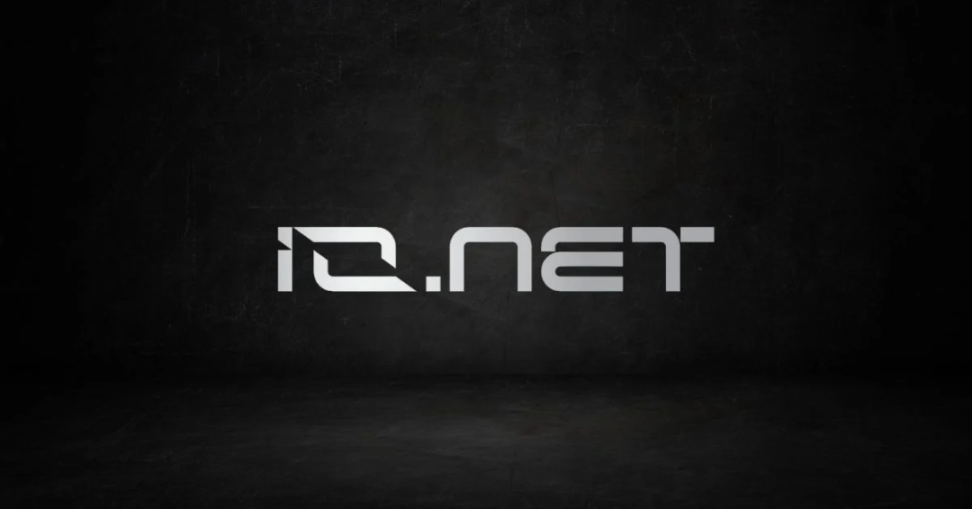
io.net addresses the shortage of computing power by aggregating underutilized computing resources, such as independent data processing centers, cryptocurrency miners, and surplus GPUs from other cryptocurrency projects like Filecoin and Render. This allows engineers to access a large amount of computing power in a system that is easily accessible, customizable, and cost-effective.
In addition, io.net introduces the distributed physical infrastructure network (depin), which combines resources from various providers, enabling engineers to obtain a large amount of computing power in a customizable, cost-effective, and easy-to-implement manner.
io cloud now has over 95,000 GPUs and more than 1,000 CPUs, supporting rapid deployment, hardware selection, geographical location, and providing a transparent payment process.
2. Core Mechanism
2.1 Centralized Resource Aggregation
The decentralized resource aggregation of io.net is one of its core features, allowing the platform to utilize globally dispersed GPU resources to provide necessary computational support for AI and machine learning tasks. The goal of this resource aggregation strategy is to optimize resource utilization, reduce costs, and provide broader accessibility.
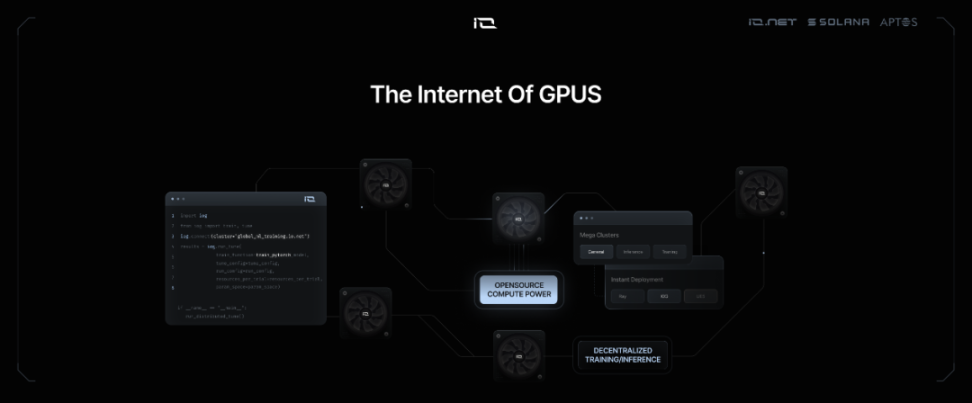
The following are detailed introductions:
2.1.1 Advantages
Cost-effectiveness: By utilizing underutilized GPU resources in the market, io.net can provide computing power at a lower cost than traditional cloud services. This is particularly important for data-intensive AI applications, as they often require a large amount of computing resources, which can be costly using traditional methods.
Scalability and flexibility: The decentralized model allows io.net to easily expand its resource pool without relying on a single vendor or data center. This model provides users with the flexibility to choose resources that best suit their task requirements.
2.1.2 Operation Principle
Diversity of resource sources: io.net aggregates GPU resources from multiple sources, including independent data centers, individual cryptocurrency miners, and surplus resources participating in other cryptocurrency projects such as Filecoin and Render.
Technical implementation: The platform uses blockchain technology to track and manage these resources, ensuring transparency and fairness in resource allocation. Blockchain technology also helps automate payments and incentives allocated to users contributing additional computing power to the network.
2.1.3 Specific Steps
Resource discovery and registration: Resource providers (such as GPU owners) register their devices on the io.net platform. The platform verifies the performance and reliability of these resources to ensure they meet specific standards and requirements.
Resource pooling: Verified resources are added to the global resource pool for platform users to rent. The distribution and management of resources are automatically executed through smart contracts, ensuring transparency and efficiency in the process.
Dynamic resource allocation: When users initiate computing tasks, the platform dynamically allocates resources based on the task's requirements (such as computing power, memory, network bandwidth, etc.). Resource allocation considers cost efficiency and geographical location to optimize task execution speed and cost.
2.2 Dual Token Economic System
The dual token economic system of io.net is one of its core features, designed to incentivize network participants and ensure the efficiency and sustainability of the platform's operation. This system includes two types of tokens: $IO and $IOSD, each playing a unique role. The following details the structure and functions of this economic system.
2.2.1 $IO Token
$IO is the primary functional token of the io.net platform, used for various network transactions and operations. Its main uses include:
Payment and fees: Users use $IO to pay for leasing computing resources, including GPU usage fees. Additionally, $IO is also used to pay for various services and fees on the network.
Resource incentives: $IO tokens are distributed to users who provide GPU computing power or participate in maintaining the network as a reward, incentivizing them to continue contributing resources.
Governance: $IO token holders can participate in the governance decisions of the io.net platform, including voting rights, influencing the platform's future development direction, and policy adjustments.
2.2.2 $IOSD Token
$IOSD is a stablecoin pegged to the US dollar, designed to provide a stable value store and trading medium for the io.net platform. Its main functions include:
Value stability: The value of $IOSD is fixed to a 1:1 peg with the US dollar, providing users with a way to avoid the volatility of the cryptocurrency market.
Simplified transactions: Users can use $IOSD to pay for platform fees, such as computing resource fees, ensuring stability and predictability in transaction value.
Fee coverage: Some network operations or transaction fees can be paid with $IOSD, simplifying the fee settlement process.
2.2.3 Operation Mechanism of the Dual Token System
The dual token system of io.net interacts in the following ways to support the operation and growth of the network:
Incentives for resource providers: Resource providers (such as GPU owners) receive $IO tokens as a reward for contributing their devices to the network. These tokens can be used to further purchase computing resources or traded on the market.
Fee payment: Users use $IO or $IOSD to pay for the use of computing resources. Choosing $IOSD can mitigate the risk of cryptocurrency market fluctuations.
Incentivizing economic activities: Through the circulation and use of $IO and $IOSD, the io.net platform can stimulate economic activities, increasing the liquidity and participation of the network.
Governance participation: $IO tokens also serve as governance tokens, allowing holders to participate in the governance process of the platform, such as proposing and voting on decisions.
2.3 Dynamic Resource Allocation and Scheduling
The dynamic resource allocation and scheduling of io.net is one of the core features of the platform, crucial for efficiently managing and optimizing the use of computing resources to meet diverse computing needs of users. This system ensures that computing tasks are executed on the most suitable resources, maximizing resource utilization and performance in an intelligent and automated manner.
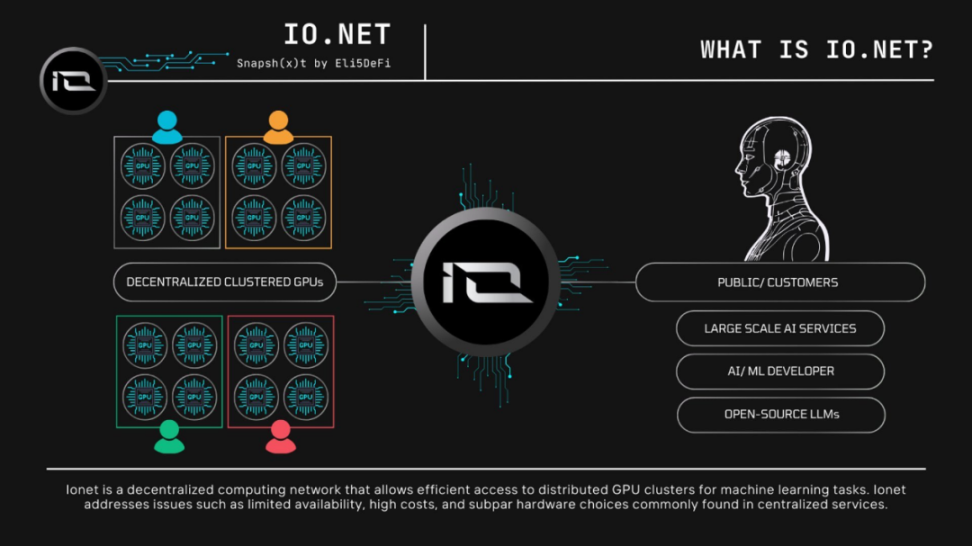
The following details various aspects of this mechanism:
2.3.1 Dynamic Resource Allocation Mechanism
- Resource identification and categorization:
When resource providers connect their GPUs or other computing resources to the io.net platform, the system first identifies and categorizes these resources. This includes evaluating their performance metrics such as processing speed, memory capacity, network bandwidth, etc.
These resources are then tagged and archived for dynamic allocation based on different task requirements.
- Demand matching:
When users submit computing tasks to io.net, they specify the task's requirements, such as required computing power, memory size, budget constraints, etc.
The platform's scheduling system analyzes these requirements and filters matching resources from the resource pool.
- Intelligent scheduling algorithm:
Utilizes advanced algorithms to automatically match the most suitable resources with submitted tasks. These algorithms consider the performance, cost efficiency, geographical location (to reduce latency), and specific preferences of the resources.
The scheduling system also monitors the real-time status of resources, such as availability and load, to dynamically adjust resource allocation.
2.3.2 Scheduling and Execution
- Task queue and priority management:
All tasks are queued based on priority and submission time. The system processes the task queue based on preset or dynamically adjusted priority rules.
Urgent or high-priority tasks can receive quick responses, while long-term or cost-sensitive tasks may be executed during low-cost periods.
- Fault tolerance and load balancing:
The dynamic resource allocation system includes fault tolerance mechanisms to ensure tasks can smoothly migrate to other healthy resources and continue execution even if some resources fail.
Load balancing technology ensures that no single resource is overloaded, optimizing the performance of the entire network by fairly distributing task loads.
- Monitoring and adjustment:
The system continuously monitors the execution status of all tasks and the operational status of resources. This includes real-time analysis of task progress, resource consumption, and other key performance indicators.
Based on this data, the system may automatically readjust resource allocation to optimize task execution efficiency and resource utilization.
2.3.3 User Interaction and Feedback
Transparent user interface: io.net provides an intuitive user interface where users can easily submit tasks, view task status, and adjust requirements or priorities.
Feedback mechanism: Users can provide feedback on task execution results, and the system adjusts future task resource allocation strategies based on the feedback to better meet user needs.
3. System Architecture
3.1 IO Cloud
IO Cloud is designed to simplify the deployment and management of decentralized GPU clusters, providing scalable and flexible GPU resource access for machine learning engineers and developers without significant hardware investment. This platform offers an experience similar to traditional cloud services but with the advantages of a decentralized network.
Highlights:
Scalability and cost-effectiveness: Aimed to be the most cost-effective GPU cloud, reducing AI/ML project costs by up to 90%.
Integrated with IO SDK: Seamlessly integrated to enhance AI project performance, creating a unified high-performance environment.
Global coverage: Distributed GPU resources optimizing machine learning services and inference, similar to CDN.
RAY framework support: Utilizes the RAY distributed computing framework for scalable Python application development.
Exclusive features: Provides private access to the OpenAI ChatGPT plugin for easy deployment of training clusters.
Cryptocurrency mining innovation: Seeks to innovate cryptocurrency mining by supporting the machine learning and artificial intelligence ecosystem.
3.2 IO Worker
IO Worker aims to simplify and optimize supply operations for WebApp users. This includes user account management, real-time activity monitoring, temperature and power tracking, installation support, wallet management, security, and profitability analysis.
Highlights:
Worker dashboard: Provides real-time monitoring dashboard for connected devices with the ability to delete and rename devices.
Device details page: Displays comprehensive device analytics, including traffic, connection status, and work history.
Earnings and rewards page: Tracks earnings and work history, with transaction details accessible on SOLSCAN.
Add new device page: Simplifies the device connection process, supporting quick and easy integration.
3.3 IO Explorer
IO Explorer is designed as a comprehensive platform to provide users with in-depth insights into the operation of the io.net network, similar to how a blockchain explorer provides transparency for blockchain transactions. Its main goal is to enable users to monitor, analyze, and understand detailed information about the GPU cloud, ensuring complete visibility into network activities, statistics, and transactions while protecting the privacy of sensitive information.
Advantages:
Browser homepage: Provides insights into supply, verified suppliers, active hardware count, and real-time market pricing.
Cluster page: Displays public information about deployed clusters in the network, along with real-time metrics and reservation details.
Device page: Displays public details of devices connected to the network, providing real-time data and transaction tracking.
Real-time cluster monitoring: Provides real-time insights into cluster status, health, and performance, ensuring users have the latest information.
3.4 IO-SDK
IO-SDK is the foundational technology of Io.net, stemming from Ray technology. It enables tasks to run in parallel and handle different languages, compatible with major machine learning (ML) frameworks, making IO.NET flexible and efficient for various computing needs. This setup, along with a well-defined set of technologies, ensures that the IO.NET Portal can meet today's demands and adapt to future changes.
Multi-layered architecture:
User interface: Serves as the visual front end for users, including public websites, client areas, and GPU provider areas. Designed to be intuitive and user-friendly.
Security layer: Ensures the integrity and security of the system, including network protection, user authentication, and activity logging.
API layer: Serves as the communication hub for the website, providers, and internal management, facilitating data exchange and operations.
Backend layer: The core of the system, handling cluster/GPU management, customer interactions, and automatic scaling operations.
Database layer: Stores and manages data, with the main storage used for structured data and caching used for temporary data.
Task layer: Manages asynchronous communication and tasks, ensuring the efficiency of execution and data flow.
Infrastructure layer: Infrastructure containing GPU pools, orchestration tools, and execution/ML tasks, equipped with powerful monitoring solutions.
3.5 IO Tunnels
Utilizes reverse tunneling technology to create secure connections from the client to remote servers, enabling engineers to bypass firewalls and NAT for remote access without complex configurations.
Workflow: IO Worker connects to the intermediary server (io.net server). Then, the io.net server listens for connections from IO Worker and engineer machines, facilitating data exchange through reverse tunnels.
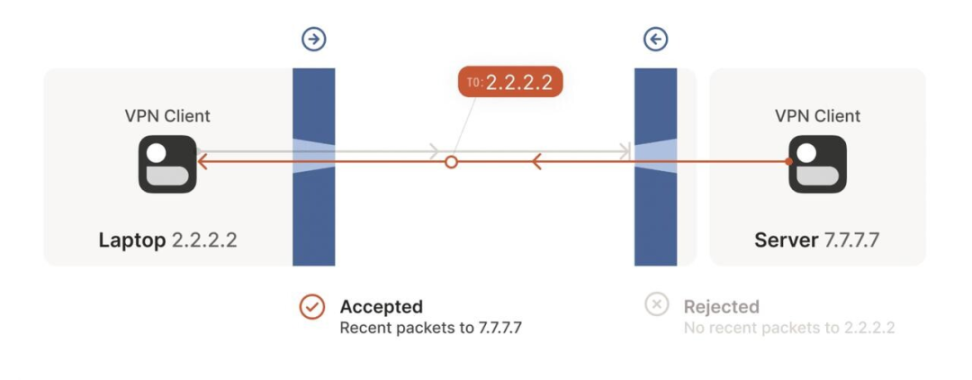
Application in io.net
Engineers connect to IO Workers through the io.net server, simplifying remote access and management without network configuration challenges.
Advantages:
Convenience of access: Direct access to IO Workers, eliminating network barriers.
Security: Ensures protected communication and maintains data privacy.
Scalability and flexibility: Effectively manage multiple IO Workers in different environments.
3.6 IO Network
The IO Network adopts a mesh VPN architecture to provide ultra-low latency communication between antMiner nodes.
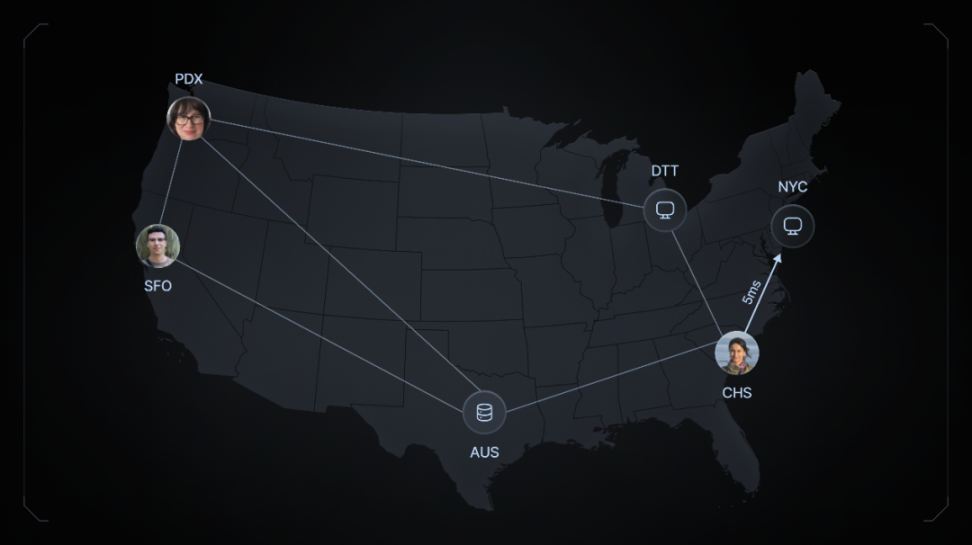
Mesh VPN network:
Decentralized connectivity: Unlike traditional star models, the mesh VPN directly connects nodes, providing enhanced redundancy, fault tolerance, and load balancing.
Advantages: Strong resistance to node failures, strong scalability, low latency, and optimized traffic allocation.
Benefits of io.net:
Direct connections reduce latency and optimize application performance.
No single point of failure, allowing the network to continue running even if a single node fails.
Enhances user privacy by making data tracking and analysis more challenging.
The addition of new nodes does not affect performance.
More efficient resource sharing and processing between nodes.
4. $IO Token
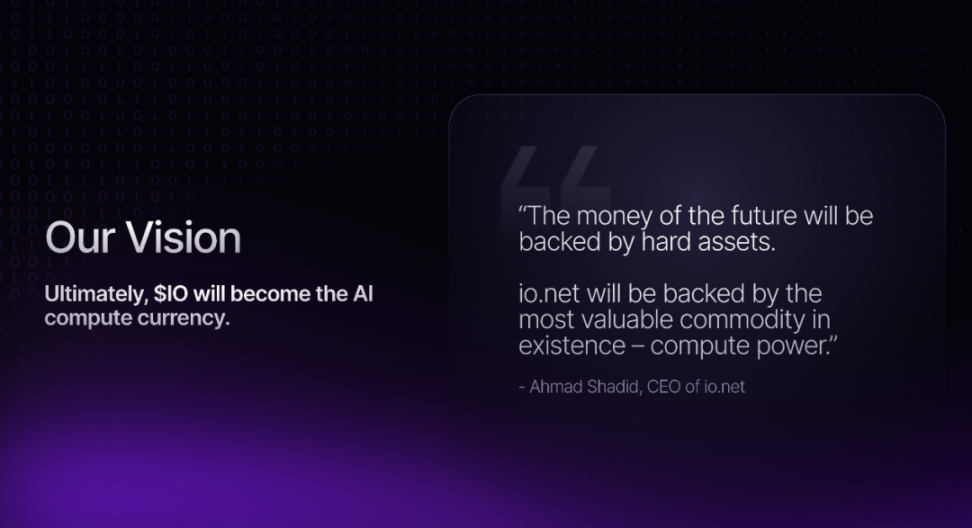
4.1 Basic Framework of $IO Token
- Fixed supply:
- The maximum supply of $IO tokens is fixed at 800 million. This supply setting aims to ensure the stability of token value and prevent inflation.
- Allocation and incentives:
Initially, 300 million $IO tokens will be distributed. The remaining 500 million tokens will be distributed as rewards to providers and their shareholders, a process expected to last 20 years.
Rewards are released hourly and follow a decreasing model (starting at 8% in the first year, decreasing by 1.02% monthly, approximately 12% annually), until the total issuance limit of 800 million tokens is reached.
- Burn mechanism:
- $IO adopts a programmatic token burn system, using income generated from the io.net to purchase and burn $IO tokens. The burn mechanism adjusts the amount of tokens burned based on the price of $IO, creating deflationary pressure on the tokens.
4.2 Fees and Revenue
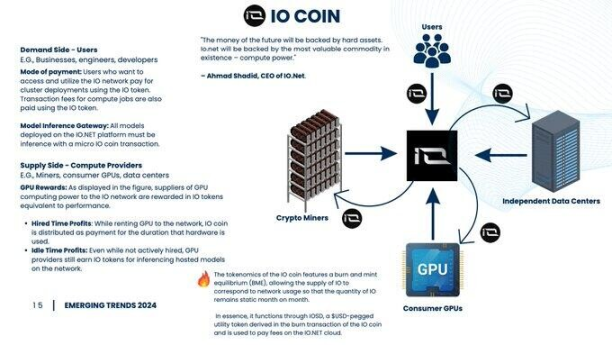
Usage fees:
- io.net charges users and providers various fees, including reservation fees and payment fees when booking computing power. These fees are designed to maintain the financial health of the network and support the market circulation of $IO.
Payment fees:
- A 2% fee is charged for payments made using USDC; no fees are charged for payments made using $IO.
Provider fees:
- Similar to users, providers are also required to pay corresponding fees upon receiving payments, including reservation fees and payment fees.
4.3 Ecosystem
GPU renters (also known as users), such as machine learning engineers looking to purchase GPU computing power on the IOG network. These engineers can use $IO to deploy GPU clusters, cloud gaming instances, and build Unreal Engine 5 (and similar) pixel streaming applications. Users also include individual consumers looking to perform serverless model inference on BC8.ai and the hundreds of applications and models that io.net will host in the future.
GPU owners (also known as providers), such as independent data centers, crypto mines, and professional miners, looking to provide underutilized GPU computing power on the IOG network and profit from it.
$IO token holders (also known as the community) participate in providing cryptographic economic security and incentive measures to coordinate mutual benefits and penalties, promoting the development and adoption of the network.
4.4 Specific Allocation
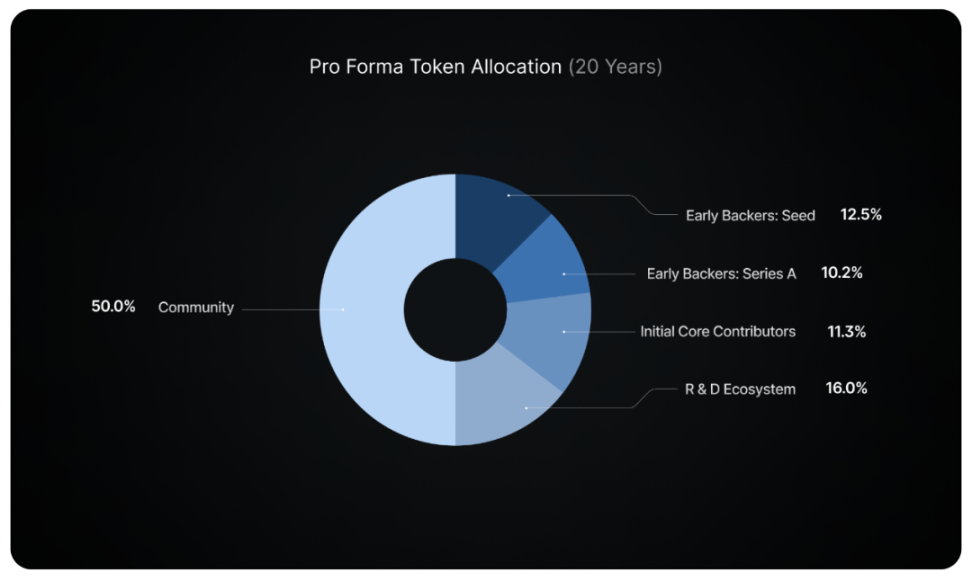
Community: 50% of the total allocation, primarily used to reward community members, incentivize platform participation and growth.
Research and Development (R&D) Ecosystem: 16%, used to support platform research and development activities and ecosystem development, including partners and third-party developers.
Initial Core Contributors: 11.3%, rewarding team members who made key contributions in the early stages of the platform.
Early Backers: Seed: 12.5%, allocated to early seed investors to reward their trust and financial support in the early stages of the project.
Early Backers: Series A: 10.2%, allocated to Series A investors to reward their early-stage financial and resource contributions to the project's development.
4.5 Halving Mechanism

2024 to 2025: 6,000,000 $IO tokens will be released annually during these two years.
2026 to 2027: Starting from 2026, the annual release amount will be halved to 3,000,000 $IO tokens.
2028 to 2029: The release amount continues to halve, with 1,500,000 $IO tokens released annually.
5. Team / Partnerships / Financing Situation
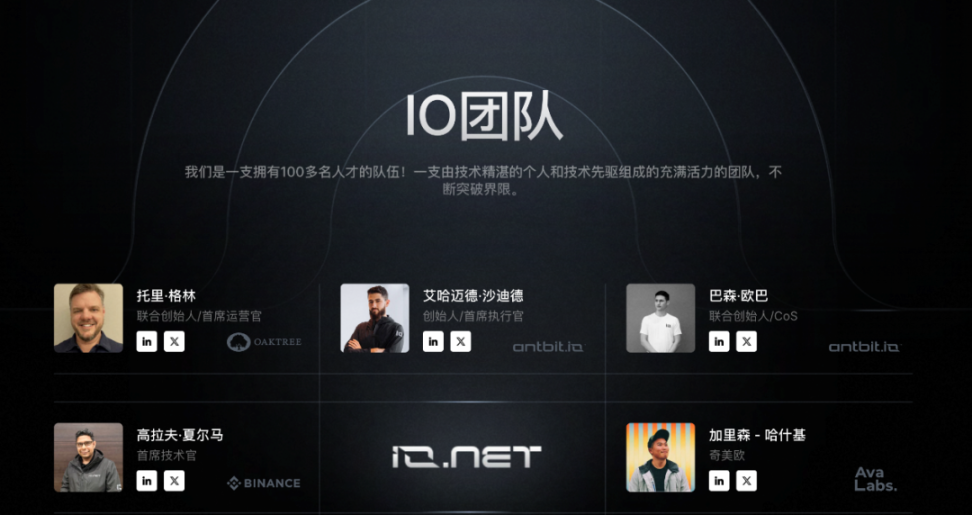
io.net has a leadership team with diverse skills and experience, contributing to the company's success with decades of experience in the technology field.
Tory Green is the Chief Operating Officer of io.net, previously serving as the Chief Operating Officer of Hum Capital and the Director of Corporate Development and Strategy at Fox Mobile Group.
Ahmad Shadid is the Founder and CEO of io.net, previously working as a Quantitative Systems Engineer at WhalesTrader.
Garrison Yang is the Chief Strategy Officer and Chief Marketing Officer of io.net, previously serving as the Vice President of Growth and Strategy at Ava Labs. He graduated from the University of California, Santa Barbara with a major in Environmental Health Engineering.
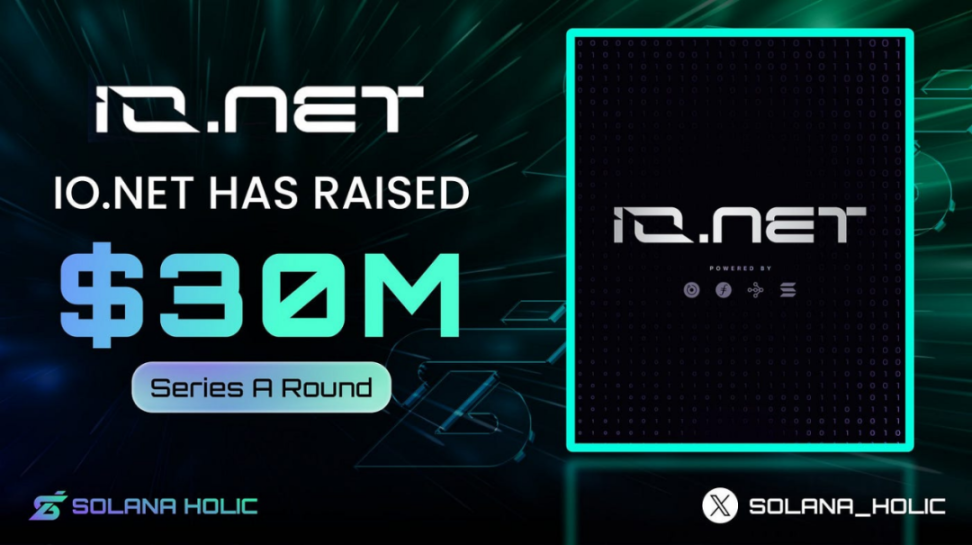
In March of this year, io.net secured a $30 million Series A financing round led by Hack VC, with participation from Multicoin Capital, 6th Man Ventures, M13, Delphi Digital, Solana Labs, Aptos Labs, Foresight Ventures, Longhash, SevenX, ArkStream, Animoca Brands, Continue Capital, MH Ventures, and OKX, as well as industry leaders including Solana founder Anatoly Yakovenk, Aptos founders Mo Shaikh and Avery Ching, Animoca Brands' Yat Siu, and Jin Kang of Perlone Capital.
6. Project Evaluation
6.1 Track Analysis
io.net is a decentralized computing network based on the Solana blockchain, focusing on providing powerful computing capabilities by integrating underutilized GPU resources. The project primarily operates in the following track areas:
- Decentralized Computing
io.net has built a decentralized physical infrastructure network (Depin) utilizing GPU resources from various sources such as independent data centers and crypto miners. This decentralized approach aims to optimize the utilization of computing resources, reduce costs, and increase accessibility and flexibility.
- Cloud Computing
While adopting a decentralized approach, io.net provides services similar to traditional cloud computing, such as GPU cluster management and scalability for machine learning tasks. The goal of io.net is to create an experience similar to traditional cloud services but leveraging the advantages of a decentralized network to provide more efficient and cost-effective solutions.
- Blockchain Technology Applications
As a project based on blockchain technology, io.net leverages blockchain features such as security and transparency to manage resources and transactions within the network.
Projects similar to io.net in functionality and goals include:
Golem: Also a decentralized computing network where users can rent or offer unused computing resources. Golem aims to create a global supercomputer.
Render: Provides graphic rendering services using a decentralized network. Render utilizes blockchain technology to allow content creators access to more GPU resources, accelerating the rendering process.
iExec RLC: This project has created a decentralized marketplace allowing users to rent out their computing resources. iExec supports various types of applications, including data-intensive applications and machine learning workloads, through blockchain technology.
6.2 Project Advantages
Scalability: io.net is specifically designed as a highly scalable platform to meet bandwidth demands and enable easy workload expansion on the GPU network without significant adjustments.
Batch Inference and Model Serving: The platform supports parallelized inference on data batches, allowing machine learning teams to deploy workflows on a distributed GPU network.
Parallel Training: To overcome memory limitations and sequential workflows, io.net utilizes distributed computing libraries to parallelize training tasks across multiple devices.
Parallel Hyperparameter Tuning: Leveraging inherent parallelism in hyperparameter tuning experiments, io.net optimizes scheduling and search patterns.
Reinforcement Learning (RL): With support for highly distributed RL workloads and a simple API, io.net utilizes an open-source RL library.
Instant Accessibility: Unlike long-term deployments in traditional cloud services, io.net Cloud provides instant access to GPU supply, allowing users to launch their projects within seconds.
Cost Efficiency: Designed as a cost-effective platform suitable for various user categories, io.net currently offers approximately 90% higher cost efficiency compared to competing services, providing significant savings for machine learning projects.
High Security and Reliability: The platform promises to provide top-notch security, reliability, and technical support, ensuring a secure and stable environment for machine learning tasks.
Implementation Convenience: io.net Cloud eliminates the complexity of building and managing infrastructure, enabling seamless development and expansion of AI applications for any developer and organization.
6.3 Project Challenges
1. Technical Complexity and User Adoption
Challenge: While decentralized computing offers significant cost and efficiency advantages, the technical complexity may pose a significant entry barrier for non-technical users. Users need to understand how to operate a distributed network and effectively utilize distributed resources.
Impact: This may limit the widespread adoption of the platform, especially among user groups less familiar with blockchain and distributed computing.
2. Network Security and Data Privacy
Challenge: While blockchain provides enhanced security and transparency, the openness of decentralized networks may make them more susceptible to network attacks and data breaches.
Impact: This requires io.net to continuously strengthen its security measures to ensure the confidentiality and integrity of user data and computing tasks, which is crucial for maintaining user trust and platform reputation.
3. Performance and Reliability
Challenge: While io.net aims to provide efficient computing services through decentralized resources, coordinating between different geographical locations and varying qualities of hardware resources may pose challenges in performance and reliability.
Impact: Any performance issues arising from hardware mismatches or network latency could affect customer satisfaction and the overall effectiveness of the platform.
4. Scalability
Challenge: Despite designing a highly scalable network, effectively managing and expanding decentralized resources on a global scale remains a significant technical challenge in practice.
Impact: This requires ongoing technological innovation and management improvements to maintain stability and responsiveness in the face of rapidly growing user and computing demands.
5. Competition and Market Acceptance
Challenge: io.net faces competition in the blockchain and decentralized computing market. Other platforms such as Golem, Render, and iExec also provide similar services, and the rapidly changing market may quickly alter the competitive landscape.
Impact: To maintain competitiveness, io.net needs to continuously innovate and enhance the uniqueness and value of its services to attract and retain users.
7. Conclusion
In conclusion, io.net has set a new benchmark in the modern cloud computing arena with its innovative decentralized computing network and blockchain-based architecture. By aggregating underutilized GPU resources globally, io.net provides unprecedented computing power, flexibility, and cost efficiency for machine learning and artificial intelligence applications. This platform not only makes the deployment of large-scale machine learning projects faster and more economical but also provides robust security and scalable solutions for various user categories.
Facing challenges such as technical complexity, network security, performance stability, and market competition, if IO.Net can overcome these challenges and nurture a vibrant ecosystem, it has the potential to fundamentally reshape the way we access and utilize computing power in the Web3 era. However, like any emerging technology, it is important to recognize that its long-term success will depend on the ability to continuously develop, adopt, and harness the evolving landscape of blockchain-based infrastructure.
免责声明:本文章仅代表作者个人观点,不代表本平台的立场和观点。本文章仅供信息分享,不构成对任何人的任何投资建议。用户与作者之间的任何争议,与本平台无关。如网页中刊载的文章或图片涉及侵权,请提供相关的权利证明和身份证明发送邮件到support@aicoin.com,本平台相关工作人员将会进行核查。



